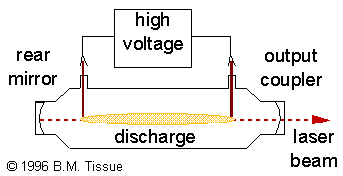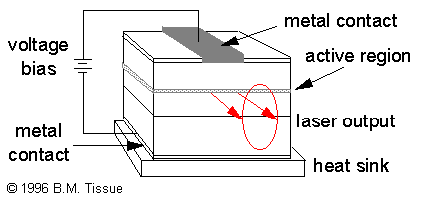A laser is a coherent and highly directional radiation source. LASER stands for Light Amplification by Stimulated Emission of Radiation.
A laser consists of at least three components:
Gas lasers are typically excited by an electrical discharge.
Schematic of a cw gas laser
Some gas lasers and their dominant lasing wavelength(s):
- excimer : ArF* - 248 nm, XeCl* - 308 nm (pulsed)
- nitrogen : 337 nm (pulsed)
- He-Ne : 632.8 nm (cw)
- Ar ion : 488, 541 nm (cw)
- CO2 : 10.6 µm (cw or pulsed)
The gain medium in a solid-state laser is an impurity center in a crystal or glass. Solid-state lasers made from semiconductors are described below. The first laser was a ruby crystal (Cr3+ in Al2O3) that lased at 694 nm when pumped by a flashlamp. The most commonly used solid-state laser is one with Nd3+ in a Y3Al5O8 (YAG) or YLiF4(YLF) crystal or in a glass. These Nd3+ lasers operate either pulsed or cw and lase at approximately 1064 nm. The high energies of pulsed Nd3+:YAG lasers allow efficient frequency doubling (532 nm), tripling (355 nm), or quadrupling (266 nm), and the 532 nm and 355 nm beams are commonly used to pump tunable dye lasers. Dye Lasers
The gain medium in a dye laser is an organic dye molecule that is dissolved in a solvent. The dye and solvent are circulated through a cell or a jet, and the dye molecules are excited by flashlamps or other lasers. Pulsed dye lasers use a cell and cw dye lasers typically use a jet. The organic dye molecules have broad fluorescence bands and dye lasers are typically tunable over 30 to 80 nm. Dyes exist to cover the near-uv to near-infrared spectral region: 330 - 1020 nm.
Schematic of a pulsed dye laser Semiconductor Lasers
Semiconductor Lasers
Semiconductor lasers are light-emitting diodes within a resonator cavity that is formed either on the surfaces of the diode or externally. An electric current passing through the diode produces light emission when electrons and holes recombine at the p-n junction. Because of the small size of the active medium, the laser output is very divergent and requires special optics to produce a good beam shape. These lasers are used in optical-fiber communications, CD players, and in high-resolution molecular spectroscopy in the near-infrared. Diode laser arrays can replace flashlamps to efficiently pump solid-state lasers. Diode lasers are tunable over a narrow range and different semiconductor materials are used to make lasers at 680, 800, 1300, and 1500 nm.
Schematic of a semiconductor diode laser Related Topics
Related Topics
- Optics
- Optical Materials
